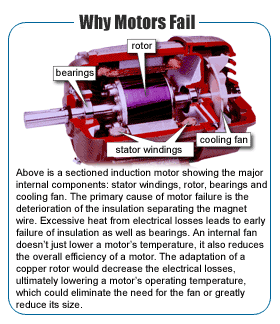
A large industrial mill or plant can spend upwards of $1 million annually on energy costs. The Motor Decisions MatterSM campaign, launched by the Consortium for Energy Efficiency (CEE) along with a number of sponsors including the Copper Development Association and the U.S. Department of Energy (DOE), aims to help businesses control these costs through better motor management.
According to the DOE, a more thorough approach to motor management than is being practiced today could save manufacturers 18 percent in energy costs annually. The Motor Decisions Matter campaign delivers information to manufacturers to aid them in making better motor management decisions. "We want corporate and plant managers to realize the financial and performance benefits of sound motor management, which includes proper motor planning, evaluation and analysis, inventory, procurement and repair," explains Ted Jones, of the Center for Energy Efficiency. "By addressing the motor decision-making process, businesses can more effectively capture energy savings in the motor replacement market, while also taking advantage of the savings potential of proper motor repair, sizing and management."
The immediate goal of a manufacturer is to quickly restore operations when a motor fails. Unfortunately, many decisions to repair or replace a motor are based on short-term economics. In the long run, the cost of such decisions can be high, as operational costs may increase and equipment performance may suffer. According to figures on the campaign's Web site, a recent study reveals that only 19 percent of personnel at U.S. industrial facilities were aware of premium-efficiency motors, and only 11 percent of customers reported having written specifications for motor purchases, with only two-thirds of these customers including efficiency in their specifications.
A key component of the campaign is its Motor Planning Kit, a resource to aid businesses in the development of a motor management plan. Among its many features, are tools that help estimate annual motor operating costs and information about industry-standard practices and guidelines.
Sponsors of the Motor Decisions Matter Campaign, besides CDA and the DOE are: Advanced Energy, A.O. Smith, Baldor, Conectiv, Electrical Apparatus Service Association, Emerson Motors, GE Industrial Systems, Leeson, Lincoln Motors, Long Island Power Authority, Marathon Electric, Midwest Energy Efficiency Alliance, National Electrical Manufacturers Association, National Grid USA, Northeast Energy Efficiency Alliance, Northeast Utilities, Northwest Energy Efficiency Alliance, New York State Energy Research and Development Authority, Reliance Electric, Siemens, Sacramento Municipal Utility District, Southern California Edison, Toshiba, U.S. Department of Energy, U.S. Environmental Protection Agency, WEG Electric and Wisconsin Focus on Energy.
Copper-Rotor Motors Boost Efficiency
Motor manufacturers have known for some time that replacing the aluminum conductor structure of the rotor with copper would significantly increase the electrical energy efficiency of the motor and, therefore, significantly reduce lifetime operating costs. For this reason, some special purpose motors and many very large motors are built with copper rotor structures by a costly and slow fabrication process.
Notably, the level of energy efficiency being achieved through the CDA copper motor rotor project exceeds the efficiency of currently produced motors and any efficiency guidelines in place by the Consortium for Energy Efficiency, the U.S. Department of Energy, or the National Electrical Manufacturers Association. In fact, the project's efficiency tests show that motors with copper conductor bars in the rotors yield overall loss reductions of from 15% to more than 20%, compared to their aluminum counterparts, for the same lamination and rotor designs, according to CDA's Dr. John Cowie, manager of the copper motor rotor project. For this reason, some special purpose motors and many very large motors are built with copper rotor structures by a costly and slow fabrication process.
The potential total energy savings in applying copper to the rotors of medium-power motors are a significant national consideration. The DOE has determined that electric motor systems account for 23 percent of all electricity consumed in the United States, nearly 70 percent of which is consumed in the manufacturing sector. CDA expects integral horsepower motors with copper rotors to become the replacements of choice for end users when they are available. According to Dr. Cowie, replacement copper rotors should begin to become available sometime next year. CDA is partnering with a rotor manufacturer for fabricating 100 rotors to go into service early next year.
